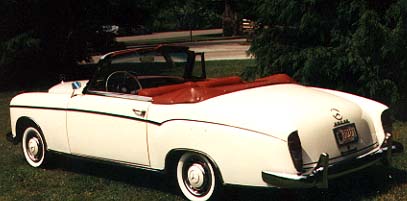
![]()
INTRODUCTION
--------------------

These very collectible cabriolets and coupes are referred to as 'Ponton' cars, which has to do with the front suspension subframe design. When it first came out, a German journalist likened to a pontoon or bridge spanning the engine bay. (see photo)
More adventurous in styling than the saloons, convertibles and coupes for this series came with plenty of options including fitted luggage, two-tone paint, a front bench seat and whitewall tires. These were among the last Mercedes Benz which offered a manual transmission only.
HISTORY of the 220S & 220 SE Cabriolet & Coupe
The first 220S Cabriolet was introduced at the Frankfurt Auto Show in September of 1955. The first production cabriolet rolled off the assembly line in July of 1956. The coupes followed in October of 1956.
These cars were very luxurious for their time. Of course the larger 300 series cars were even more glamourous and exclusive. Mercedes Benz realized that there was a market for a less expensive, more personal automobile. This was achieved by shortening the chassis of the very successful 220 Sedan by 4.7 inches and adding lots of chrome, wood and leather. Still hand-built, these elegant automobiles were very driveable. The platform for these fine automobiles are very different from their sedan counterparts. There are additional floor reinforcements to compensate for the abscence of a roof, the overhang behind the rear wheel is longer. Longer doors made for a very appealing look to the car and to save weight, the doors were steel skimmed over alloy frames. Lower in weight, with better structural strength than the previous model, the 220 was a better handling car as well.
In 1959 the cabriolets and coupes received the 2.2 liter fuel injected power plant which gave them more power which they needed as they are very heavy automobiles.
Produced until November 1960 there were only 5371 Ponton coupe and cabriolets built over the four years of production, making it a very rare automobile.
Mechanically these coupes and cabriolets are identical to their sedan counterparts, so mechanical parts are available. Some items are getting hard to find. All 220's are fairly predictable. All will need water pumps and engine mounts. Exhaust systems hang low and door locks can get worn, windshield wipers are sluggish. Rust is a particular problem. (see diagrams below for most common areas for rust problems.
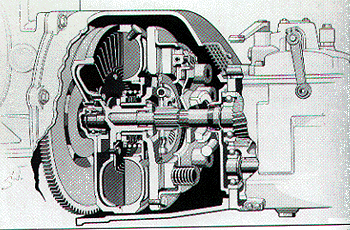 These
are very rugged automobiles and will make a great addition as an occational
driver or even as a second full time driver. They are not very fast due
to the weight and low horsepower but they will run with traffic safely.
These
are very rugged automobiles and will make a great addition as an occational
driver or even as a second full time driver. They are not very fast due
to the weight and low horsepower but they will run with traffic safely.
They were only available with a four speed and a Hydrak clutch was available. The Hydrak clutch was a innovative option.(see photo at left) The clutch would actuate automatically as the driver moved the gear shift lever which would give you two pedal control with manual shifting and no clutch pedal.
There were many problems with the Hydrak so it became one of Mercedes Benz's less successful options. Most Hydrak clutches have been converted to a regular clutch system and a pedal installed.
![]()
Production Numbers:
Production Numbers on the 220S Cabriolets and Coupes from July 1956 to October 1959
| coupes | 1251 |
| cabriolets
|
2178
|
| total: | 3429 units |
![]()
Production Numbers of the 220SE Cabriolets and Coupes from July/October 1958 to November 1960
| coupes | 830 |
| cabriolets
|
1112
|
| total: | 1942 units |
![]()
Buying A 220S & 220 SE Cabriolet & Coupe
Know what you're buying and what to look for and know what to avoid.
When these cars are well maintained and properly taken care of, they increase in value. Currently:(these are approximate values based on actual sales of vehicles.) -------------------------------------------------------------values last updated SEPTEMBER/2016-
PLEASE READ THIS FIRST!
A car's value is determined by condition. Standard condition guidelines are as follows:
Excellent- A close to perfect original or a very well restored vehicle. Generally a body-off restoration, but a well done body-on restoration that has been fully detailed may qualify. The vehicle is stunning to look at and any flaws are trivial and not readily apparent. Everything works as new, all equipment is original, NOS or excellent quality reproductions. PLEASE KEEP IN MIND THAT # 1 CARS ARE VERY RARE, AND ARE ORIGINAL RIGHT DOWN TO THE HOSE CLAMPS. DO NOT ASSUME THAT JUST BECAUSE A CAR HAS A #1 ASKING PRICE, THAT IT IS IN # 1 CONDITION. MOST CARS FOR SALE OUT THERE ARE LOW # 2 TO HIGH # 3 CARS.
Very Good- An extremely presentable vehicle showing minimal wear, or a well restored vehicle. Runs and drives smooth and tight. Needs no mechanical or cosmetic work. All areas have been detailed. Beautiful to look at but clearly not a # 1 vehicle.
Good- Presentable inside and out with some signs of wear. Not detailed but clean. Body should be straight and solid with no rust-through anywhere. Shiny, attractive paint but may have evidence of minor fading or checking or other imperfections. Runs and drives well but may need some minor mechanical or cosmetic work. But it is useable and enjoyable as is.
Fair- Runs and drives ok but needs work throughout the vehicle. Body shows signs of wear or previous restoration work. Any rust should be minimal and not in any structural areas. Cosmetics, body and mechanicals all need work to some degree.
Poor- In need of complete restoration, but is complete and not a rust bucket beyond repair. May or may not run but is not roadworthy.
These values are from Collector Car Market Review and are based on actual sales of vehicles, not on asking prices of vehicles. Asking prices, and sales prices are very different.
------------------------------------ COUPES ---------------------------------------- CABRIOLETS
| 220S | |||
| # 1 EXCELLENT | $99,000.00 | $189,000.00 | |
| # 2 VERY GOOD | $61,000.00 | $124,500.00 | |
| # 3 GOOD | $38,000.00 | $83,000.00 | |
| # 4 FAIR | $23,750.00 | $53,300.00 | |
| # 5 POOR | $12,000.00 | $28,350.00 | |
| 220SE | |||
| # 1 EXCELLENT | $113,000.00 | $220,000.00 | |
| # 2 VERY GOOD | $69,500.00 | $147,500.00 | |
| # 3 GOOD | $43,400.00 | $94,000.00 | |
| # 4 FAIR | $26,600.00 | $61,500.00 | |
| # 5 POOR | $12,900.00 | $30,500.00 | |
Keep in mind that due to the high cost of restoration, mint examples of these cars can and have sold for more than the prices quoted here.
When looking to buy one of these great automobiles, make sure it is complete. Check the windshield wipers and make sure they work. They are difficult to repair because parts are intricate and hard to locate. Make sure all the chrome is on the automobile. Chrome pieces for these coupes and cabriolets are very costly.
Condition of a car CANNOT be determined by its location. Don't be fooled by a car's current geographical location. Just because a car is in California today, does not mean that is where it started life.
Where to find the engine number and chassis number. The following illustration shows the locations of the data plates.
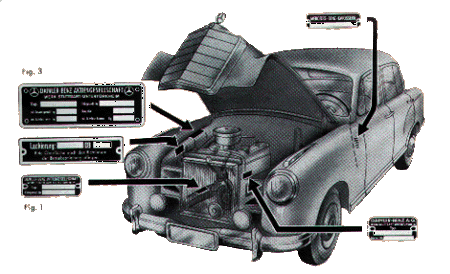
- Chassis number also stamped on forked support above the plate
- Engine plate also stamped on crankcase above the plate
- Type plate, paintcodes.
- Body plate
| Chassis prefix for 220 S is 180 |
| Chassis prefix for 220 SE is 128 |
Look at the car in general. Walk around the car several times looking at the gaps for the doors, trunk and hood. Look at the general overall condition of the car. As stated earlier, rust is the main enemy of the coupes and cabriolets, especially toward the rear of the automobiles. There is chrome trim along the bottom edge, the metal under this trim gets very rusty. Also around the wheel openings. Check the inner fender aprons and the mounting flange for the front fenders also the inner fender leading edge of the hood. Check the mounting area for the support arm on the rear under the rear seat area. Check headlight buckets, turn signal mounting areas, front fender edge around the door jamb. Check the quarter panel dogleg area around the jack points. Look at the frame lower cover sections, and lower firewall where the trunk attaches to the rear quarter panels. Look at the lower trunk lid edge as well as the trunk floor. Also check the spare tire well and the floor in the passenger compartment (especially if the car has a sunroof.) The heat ducts on the car were made from pressed cardboard, so they deteriorate. Fiberglass replacements are available. These cars are the simplest to restore. Their front end must be in top shape for precise steering.
These pontons are great cars. Very simple to maintain and fun to drive. The best tool to use for checking the condition of body panels are your hands. The following illustrations will show the most common rust areas.

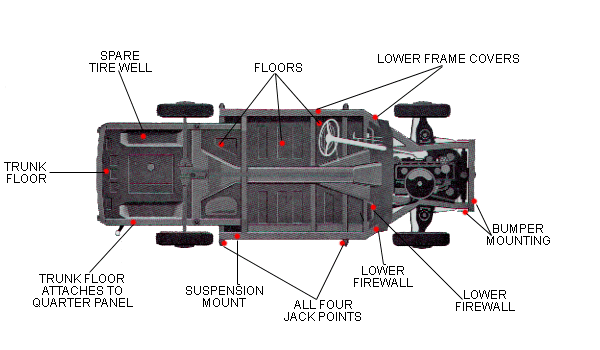
Rust is the major problem with these wonderful coupes and cabriolets. They are as rust prone as the 190 SL. However, you can still buy all of the metal parts for a 190SL, as they made 50,000 of them. So there are places making reproduction parts for them. Unfortunately this is not so for the Ponton's. All metal for them must be hand fabricated.
| Technical Specifications of the 220S & 220 SE Cabriolet & Coupe | ||
|
220S
|
220SE
|
|
| Engine Type: | 6 cyl overhead camshaft (M180) | 6 cyl overhead camshaft (M180) |
| Bore and stroke: | 80 x 72.8mm | 80 x 72.8mm |
| Displacement: | 2195 cc | 2195 cc |
| Power output: | 100 hp@4850 rpm | 100 hp@4850 rpm |
| Compression ratio: | 7.6:1 | 8.7:1 |
| Torque: | 16.5mkg @ 3500rpm | 19 mkg@ 3800 rpm |
|
Carburetion: (S) Fuel Injection: (SE) |
2 dual downdraft carburetors | Bosch two-plunger pump (into manifold) |
| Engine speed at 100km/hr: | 3320rpm | 3320rpm |
| Gear ratios: | I. 3.52:1-------------------------------- II. 2.32:1--------------------------------------------- III. 1.52:1 ------------------------------------------ IV. 1.00:1 | I. 3.65:1---------------------------------------------------- II. 2.36:1 -------------------------------------------------- III. 1.53:1------------------------------------------------- IV. 1.00:1 |
| Rear axle ratio: | 4.1 | 4.1 |
| Chassis: | unit frame and body | unit frame and body |
| Suspension: | independent front, single joint swing axle rear, with coil springs | independent front, single joint swing axle rear, with coil springs |
| Brakes and area: | drum, 1064 square cm | drum, 1064 square cm |
| Wheelbase: | 2820 mm | 2820 mm |
| Track front/rear: | 1430/1470 mm | 1430/1470 mm |
| Length: | 4750 mm | 4750 mm |
| Width: | 1740 mm | 1740 mm |
| Height: | 1560 mm | 1560 mm |
| Ground clearance: | 185 mm | 185 mm |
| Tires: | 6.7 x 13 sport | 6.7 x 13 sport |
| Turning circle: | 11.7 meters | 11.7 meters |
| Steering type and ratio: | recirculating ball, 21.4:1 | recirculating ball, 21.4:1 |
| Weight: | 3219 lbs. | 3102 lbs |
| Maximum speed: | 99.5 mph | 99.5 mph |
| Acceleration: | 17 sec 0-100 km-hr | 15 sec 0-100 km-hr |
| Fuel consumption | 13.5 L/100 km (17.4 mpg) | 13 L super /100 km (17.4 mpg) |
| Fuel tank capacity | 64 L (16.9gal.) | 62 L (16.4 gal.) |
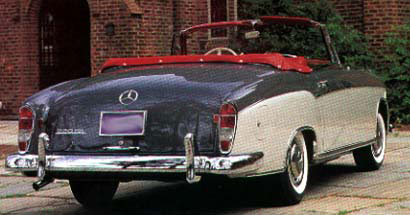
Two beautiful examples of the luxurious Ponton Cabriolets.
